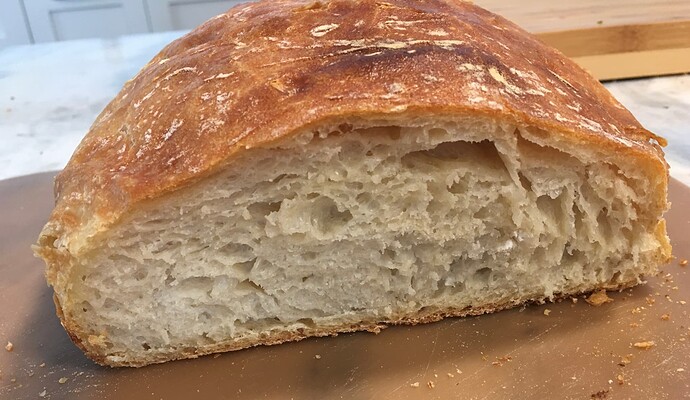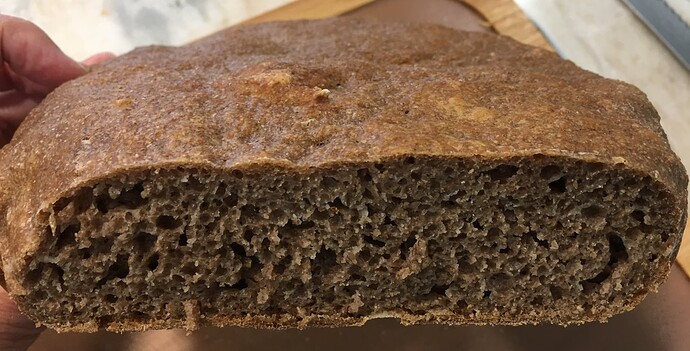Trying to convert from store bought white flour to home milled flour for my recipe.
I know what gets my perfect loaf by using store bought white flour but I would like to use my home milled flour. I know that I will need more water, but I don’t know how much more.
Original recipe calls for 400 grams of flour for 350 ml of water.
Can anyone help please? Thank you
Start off with 350ml water and slowly add extra till it feels right.
350g water for 400g bread flour is very high. I’m surprised that’s the perfect hydration for any white flour TBH. 350g water for 500g white flour sounds better!
Thanks, @Abe
It may be high, but it makes a perfect ciabatta using one of the simplest recipes I know. I just want it whole wheat home milled and not store bought.
ETA, wish I was as comfortable as you with “till it feels right”
That makes more sense @Saph16 but I reckon at that hydration even freshly milled will still work a treat. However I misunderstood as I thought you still meant to use white flour when in fact you wish to use whole wheat! Even if not freshly milled switching from white flour to whole wheat is a whole different ball game. So you wish to go from store bought white flour to freshly milled whole wheat.
This is a guess… If store bought white flour works well at 87.5% hydration then home milled whole wheat could probably take 95-100% hydration. However even if you get the hydration just right expect different results. This will be like comparing apples and oranges.
Ok. I will start off with 95% and see. Thank you very much for answering.
Still advisable to start at 87.5% hydration and work your way up. Have the extra 12.5% water on the side and slowly add it till the dough feels right. I’m sure you have an idea of how the dough should feel. Best of luck.
Thank you
I agree with @abe about starting at the lower end. Probably around 80% actually. The bran and germ soak up more water, but they also inhibit the formation of a strong gluten network. A white flour dough can be pretty wet and still feel rubbery, but a super wet whole grain flour dough may not have the elasticity to hold a shape. A lot depends on the wheat variety you’ve chosen to mill though.
For example, these are two home-milled whole grain flour recipes with different hydration needs.
88%
83%
The Yecora Rojo recipe has a no knead version that is very simple, with photos showing how much the dough should expand (more or less). You can make this with other wheat varieties too. And the Rouge de Bordeaux recipe has some stretching and folding, but it’s still a very easy process relatively speaking.
When you mix a whole grain dough above 80% hydration, it will feel pretty goopy and not cohesive at first. Let it sit for 20 minutes and then stretch and fold it into a ball inside the bowl. If at this point, it actually feels dry, go ahead and add 20g more water.
Ok, I will listen better next time. I started off with 87.5% hydration but it felt too dry to me, so I went up to 90%. That was a mistake. I should have listened and started to at least 85% or less. When I went to take it out of container after rising, there was some liquid on the bottom. Lesson learned.
The dough didn’t “puff up” in the oven during baking as it usually does. Came out flat but delish just the same. The actual taste is even better than from white flour. I used soft red wheat berries.
Probably should add some vital wheat gluten too. Here is the result.
Thank you for your help.
That is why I always autolyse at lower than the anticipated final hydration. Water can always be added when incorporating the salt. Giving the flour and water time to rest will give one a better idea of how much more water is needed. It’s easier to add water later then correct an over hydrated dough. I think if you had not added anything extra the 87.5% hydration might have worked and felt better after an autolyse. But as long as it tasted good that’s the main thing.
Looks tasty!
When dough doesn’t have oven spring, it can be over-fermentation too. Fresh-milled flours tend to ferment faster than refined white flour, and on top of that a whole grain dough may benefit from less fermentation overall, in order to retain some dough strength.
Thank you for very useful info and all your help. Really appreciate it.
I know I’m chiming in too late, but it’s important to keep in mind that whole wheat can take a little while to fully hydrate (perhaps especially freshly-milled? I’m not sure about that, but more so with some wheats than others), so it’s important to give it a lot of time to absorb before deciding to add more water. I just made this same mistake with a durum loaf despite having worked with home milled whole wheats for a couple of years.



